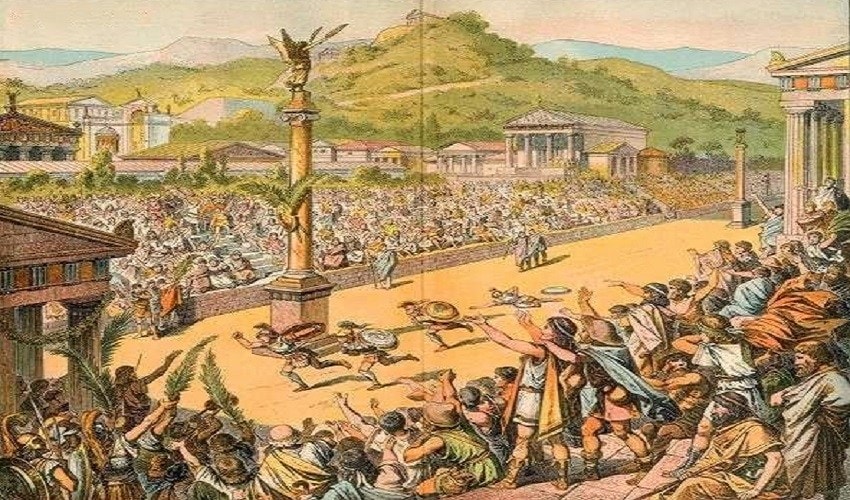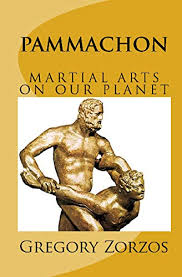A substantial amount of archaeological and historical evidence has shown that the ancient Greeks celebrated and practiced combat sports that were remarkably similar to many of the fighting sports we watch and engage in today. Pammachon is considered a long lost cousin of today's modern combat arts.
The Greeks considered combat sports a valuable tool to informally prepare young men for adult tasks and vocations, so they highly valued their role in the lives and education of their children.
Greece was the first Western country to heed the importance of combat sports—which they included in the Olympics—and they believed that through successful engagement in these events, children and young men would recognize the positive effects that competing and working as a team could have on the culture and ethics of an organized society.
Hence, combat sports were seen as an indispensable part of society in pretty much every Greek city-state, and was an ideal choice for all the young Greek males who wanted to demonstrate their athletic prowess, bravery, power, and determination.
Pammachon Origins
Wrestling, boxing, and pankration —which many historians consider the progenitor of contemporary MMA—were the three most popular combat sports in ancient Greece, as they were three of the most popular Olympic events. Despite their immense popularity and the legacy they left behind (two are still Olympic events), several modern historians have suggested that none of them was the most complete martial art of ancient Greece. That distinction probably goes to pammachon.

Source: historyonthenet.com
A long-forgotten ancient Greek martial art, pammachon was rediscovered in 1999 by Costas Dervenis, who used the name “pammachon” to describe both the martial art itself and the warrior’s path expressed through it. Even though Mr. Dervenis popularized the name only recently, there are a number of historical sources that clearly show that the ancient Greeks used this term to separate martial arts from combat sports.
In Greek, the word “machi” (μάχη) describes a combat-style confrontation between two or more people who may use weaponry such as knives, swords, or spears, or engage in unarmed battle. Hence, a proper translation of “pan-machon” (πάν-μαχον) would be “total combat,” which can include weapons or not and involves two or more fighters.
Historical Evidence
Briefly mentioned in Greek myth as a martial art Heracles and Dionysus often practiced to confront their enemies, the oldest historical reference to pammachon is found in an ancient papyrus letter translated by Sofie Remijsen of Leuven University in her article “Pammachon: A New Sport.”

Source: amazon.com
We learn from the letter that a man named Dios competed in and won the pammachon event, which was held in the presence of the emperor in Alexandria in AD March 302. Dios writes among other things, “I was at first paired up to compete in pankration but I do not have expertise in this martial art. So I challenged the five remaining athletes to compete in .”
This is considered by contemporary historians the earliest attestation of pammachon as a separate combat sport and martial art, distinct from pankration.
This distinction between the two ancient Greek martial arts is confirmed by another historical source, an honorary inscription written by an athlete named Philoumenos in AD 378, who had obtained victories in four different events: pammachon, wrestling, pankration, and boxing.
Furthermore, in the fourth century, Eusebius compared a martyr to a famed pammachon champion. Hesychius’s lexicon is another source that mentions pammachon as a popular combat sport, in Cyprus, that urban young men participated in. Interestingly, the athletes practicing pammachon were not called pammachoi, but pammacharii, as the Latin ending arius usually described the members of a profession in Roman Greece.
Revival of Pammachon and its Modern Rules
Costas Dervenis, whom we contacted in order to learn more about pammachon’s revival, informed us that this ancient martial art is now part of the Hellenic Federation of Pankration Athlima (ΕΟΠΑ). It is one of the martial arts currently used to prepare military and police personnel in Athens for close quarters combat in order to subdue and contain a hostile perpetrator who may be carrying a concealed weapon.
When it comes to the rules, things are not as clear, since the sport of pammachon is still quite green. Mr. Dervenis reassured us that the rules will be revised soon so that it will become a safer and more attractive athletic competition to younger athletes in Greece and around the world. Here are some of the basic rules in this newly revived sport:
- 1Any strike to the body is acceptable. However, only one strike to the head or face is allowed when the competitors are standing per round, and one strike when they go to the ground per round.
- 2Participants shall use soft “rubber” training blades that mold to the body and bend. “Hard” plastic or metallic knives are forbidden. Rubber weapon length cannot exceed fourteen inches.
- 3Rubber blades may not be drawn until contestants enter a standing clinch, grapple, throw, or go to the ground. Rubber blades may not be used when contestants are in “boxing” or “kicking” range in the standing position. Pammachon is not a fencing match or blade duel but is intended to simulate the use of hidden weapons in close quarters combat within grappling range.
- 4A contestant’s rubber blade may not be drawn by his opponent, but may be turned against an opponent following a disarm when he has drawn the blade himself.
- 5In cases where a participant is able to draw his rubber knife, or take his opponent’s weapon or turn the opponent’s weapon against him and successfully strike once at designated fatal targets, the fight is considered a TKO win in his favor. Fatal targets requiring only one strike with the rubber weapon are the neck, clavicle, torso centerline immediately below the sternum, lower abdomen centerline, kidney region, and groin area.
- 6Any weapon that has fallen to the ground may be used by any contestant.
- 7The head and face may not be struck with the rubber knife at any time, and such violation is cause for immediate disqualification.
The International Pammachon Union and the Hellenic Federation of Pankration Athlima provides training and certification for any affiliated instructors and athletes who wish to participate in or promote pammachon competitions.
Currently, there are only five certified training facilities in all Greece, with A.S. Pammachon in Athens being one of the best available training schools that focus almost exclusively on this ancient Greek martial art. For more information you can contact them via their Facebook Page.
